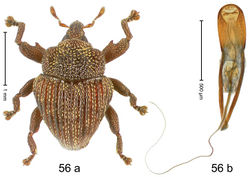Trigonopterus nothofagorum
| Notice: | This page is derived from the original publication listed below, whose author(s) should always be credited. Further contributors may edit and improve the content of this page and, consequently, need to be credited as well (see page history). Any assessment of factual correctness requires a careful review of the original article as well as of subsequent contributions.
If you are uncertain whether your planned contribution is correct or not, we suggest that you use the associated discussion page instead of editing the page directly. This page should be cited as follows (rationale):
Citation formats to copy and paste
BibTeX: @article{Riedel2013ZooKeys280, RIS/ Endnote: TY - JOUR Wikipedia/ Citizendium: <ref name="Riedel2013ZooKeys280">{{Citation See also the citation download page at the journal. |
Ordo: Coleoptera
Familia: Curculionidae
Genus: Trigonopterus
Name
Trigonopterus nothofagorum Riedel sp. n. – Wikispecies link – ZooBank link – Pensoft Profile
Diagnostic description
Holotype, male (Fig. 56a). Length 2.10 mm. Color ferruginous, center of pronotum black. Body subrhomboid; in dorsal aspect with marked constriction between pronotum and elytron; in profile with shallow constriction. Rostrum with indistinct median wrinkle and pair of submedian wrinkles, coarsely punctate; epistome forming angulate ridge, medially with weak denticle. Pronotum with subapical constriction; with indistinct lateral flanges; coarsely punctate-reticulate; punctures each with one ochre scale. Elytra heart-shaped, humeri prominent; striae deeply incised; intervals costate; sparsely squamose with ochre scales. Femora ventrally markedly dentate. Metafemur subapically with stridulatory patch. Onychium subequal to tarsomere 3, fusiform. Aedeagus (Fig. 56b) with apex rounded; transfer apparatus flagelliform; ductus ejaculatorius without bulbus. Intraspecific variation. Length 1.78–2.17 mm. Color ranging from ferruginous with black spots to largely black with few ferruginous spots. Body of females subovate. Female rostrum with rows of coarse punctures; epistome simple. Female elytra with humeri simple, not prominent as in males. Femoral tooth smaller or larger.
Material examined
Holotype (MZB): ARC0786 (EMBL # HE615469), WEST NEW GUINEA, Manokwari, Arfak Mts, S01°04.087', E133°54.268', 1520 m, 08-XII-2007, sifted. Paratypes (SMNK, ZSM): 25 exx, ARC0787 (EMBL # HE615470), ARC0788 (EMBL # HE615471), ARC0789 (EMBL # HE615472), same data as holotype; 10 exx, Mokwam, Siyoubrig, S01°06.107', E133°54.888', 1530 m, 10-XII-2007, sifted.
Distribution
Manokwari Reg. (Arfak Mts). Elevation: 1520–1530 m.
Biology
Sifted from leaf litter in montane forest dominated by Nothofagus.
Etymology
This epithet is based on the plant genus Nothofagus.
Notes
Trigonopterus nothofagorum Riedel, sp. n. was coded as “Trigonopterus sp. 235” by Tänzler et al. (2012)[1].
Original Description
- Riedel, A; Sagata, K; Surbakti, S; Rene Tänzler, ; Michael Balke, ; 2013: One hundred and one new species of Trigonopterus weevils from New Guinea ZooKeys, 280: 1-150. doi
Other References
- ↑ Tänzler R, Sagata K, Surbakti S, Balke M, Riedel A (2012) DNA barcoding for community ecology - how to tackle a hyperdiverse, mostly undescribed Melanesian fauna. PLoS ONE 7 (1): e28832. doi: 10.1371/journal.pone.0028832
Images
|
